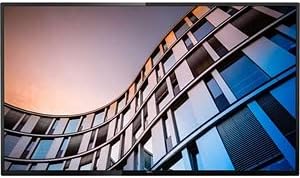Choosing between Philips and Hisense means deciding between two very different philosophies in the TV world. Philips brings a European design ethos, emphasizing OLED quality, minimalist styling, and its signature Ambilight technology that extends the viewing experience beyond the screen. Hisense, on the other hand, takes a bold, feature-first approach — delivering Mini-LED brightness, fast refresh rates, and premium-tier features at mid-tier prices.
This article breaks down how these two brands compare across real-world use cases like picture quality, gaming, brightness, smart features, and more — all organized by product class to help you find the best fit.
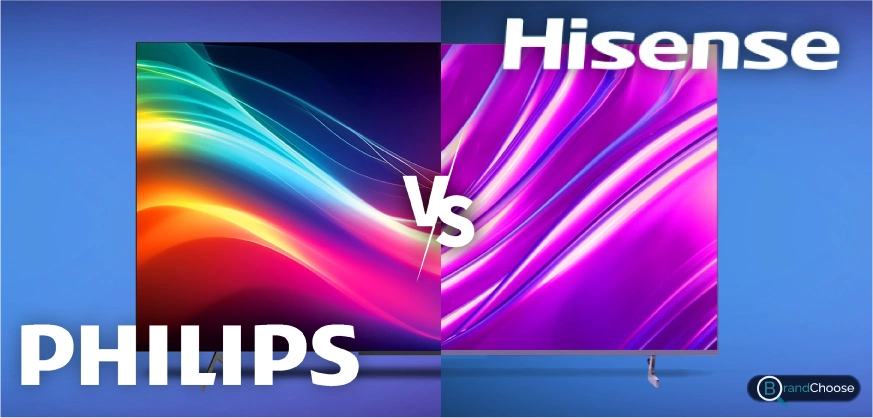
Product Selection
Understanding each brand’s product lineup is essential to comparing their TVs accurately. Throughout this article, we’ll refer to 5 general classes: Ultra Premium, Premium, Mid-Range, Budget, and Entry-Level HD. This structure helps you easily compare similar models side-by-side, even if the naming schemes vary between brands.
📌 Notes:
-
Ultra Premium: Only Hisense offers a true flagship class (UX Series). Philips does not currently sell OLED+ or Mini-LED models in the U.S., so this tier is excluded from direct comparisons.
-
Entry-Level HD: While Philips does list some 720p and 1080p models (4000, 4500, early 6000 series), they are rarely available in U.S. retail and are not part of their current mainstream strategy. Hisense A4 models, however, are widely available and affordable.
-
All main comparisons in this article focus on Premium, Mid-Range, and Budget tiers.
✅ These tiers help structure the entire article — so whether we’re talking about brightness, sound, or smart features, we’re always comparing similar-level models across both brands.


Affordability
Affordability isn’t just about low prices — it’s about how inexpensive a TV is within its class, and how accessible the brand is to different types of buyers. Here, we’re focusing purely on cost, not value. In other words: the cheaper the lineup, the more affordable the brand is — regardless of feature depth or performance.
Philips maintains a premium-oriented catalog in the U.S., while Hisense floods the market with models at nearly every price point — from flagship Mini-LEDs to sub-$300 streaming sets.
Premium Class
Philips OLED models typically start around $1,200–$1,500 for 55-inch variants and can reach well over $2,000 for larger screens. These TVs are positioned as premium home theater products and are priced accordingly. You’ll rarely find Philips premium TVs on aggressive discounts. They’re targeted at users seeking a curated, upscale experience.
Hisense’s U9 and U8 Series often retail around the same starting point — $1,200–$1,300 for Mini-LED models — but they frequently go on sale, sometimes undercutting Philips by several hundred dollars. Considering the performance level (brightness, refresh rate, gaming features), Hisense offers a strong affordability edge in the premium space, especially for deal-savvy shoppers.
Mid-Range Class
Philips 7600 and 7900 QLED models typically fall between $500 and $800, depending on size and retailer. They hold their price longer and aren’t often part of large promotional pushes, especially in the U.S. This keeps them squarely in the “respectable mid-tier” but not aggressively priced.
Hisense U7 and U6 models offer Mini-LED technology, high refresh rates, and premium features — often at the same price or lower. A 65" U8 can often be found for under $800, making it one of the best bang-for-your-buck TVs on the market. The cost-to-feature ratio at this tier heavily favors Hisense.
Budget Class
Philips 6000 and 6600 Series sit around $300–$500 for most configurations. These are often bundled with Roku or Google TV, and while not expensive, they're not as widely available — and rarely drop to “doorbuster” pricing levels.
Hisense A6, A7, and A4 Series are some of the most aggressively priced 4K and 1080p TVs on the market. It’s common to see Hisense 55" models under $250, and compact HD models under $200. They dominate entry-level retail across major stores and holiday sales. For buyers on a strict budget, Hisense is one of the most accessible TV brands available.
Affordability Summary
Hisense wins the affordability battle across every tier, offering more models at lower price points and delivering aggressive promotions throughout the year. Philips positions itself as a more selective, premium choice — with fewer budget options and less frequent pricing drops.
Picture Quality
Top-Rated Picture Quality Brands
Picture quality is the foundation of the TV experience. It determines how realistic, immersive, and satisfying your movies, shows, and games look and feel. It includes key elements like contrast, color accuracy, black level depth, HDR performance, and motion clarity — all of which vary depending on the panel type, processor, and backlighting tech used.
Philips and Hisense take different routes here: Philips leans on the deep contrast and visual subtlety of OLED and QLED panels, while Hisense brings the brightness and intensity of Mini-LED to the forefront. Let’s compare how they perform across three main TV classes.

Premium Class
Philips OLED TVs — including models like the OLED807 — focus on delivering an authentic, cinema-grade picture. With self-emissive OLED pixels, they produce true blacks, superb contrast, and color accuracy that feels natural rather than overly boosted. HDR content looks rich and clean, and motion is smooth, even without aggressive frame interpolation. Paired with Ambilight, the picture feels larger and more atmospheric, especially in dark rooms.
Hisense U9 and UX Series use Mini-LED backlighting with thousands of dimming zones to simulate OLED-like contrast while achieving far higher peak brightness (up to 2,500 nits). The image is bold, vivid, and tuned for high visual impact. HDR content jumps off the screen, and gamers will appreciate the fast 144–165Hz refresh rate and Game Mode Pro. Colors are slightly more saturated than Philips, offering a flashier look that’s ideal for bright-room viewing or sports.
Mid-Range Class
Philips’ 7600 and 7900 Series QLED models aim for a balanced picture profile. They deliver good brightness for casual viewing, with accurate skin tones and stable performance across different content types. The 7600’s 144Hz refresh rate adds fluidity for games and action scenes. However, these TVs don’t feature advanced local dimming, so black levels and contrast control remain limited compared to Mini-LED rivals.
Hisense U8 and U7 Series punch far above their price. Thanks to Mini-LED tech, they offer deep contrast, strong HDR peak brightness, and vivid, high-impact color. Motion interpolation is smooth, and gaming feels fast and responsive. These TVs often outperform more expensive competitors in raw visual output, making them great for bright living rooms or fast-paced content.
Budget Class
Philips 6000 and 6600 models stick to the essentials. They’re LED-based, with decent 4K upscaling and reliable color reproduction, but the panels have limited contrast, weaker shadow detail, and almost no HDR impact. These TVs are best for non-demanding use like casual streaming in secondary rooms.
Hisense’s A6 and A7 Series offer slightly better contrast and brightness, along with support for HDR10, Dolby Vision, and Game Mode in many models. Their picture looks livelier, with improved depth in darker scenes and stronger highlights, even though they’re still entry-level panels. These are good all-rounders for budget-conscious buyers who still want visual clarity.
Picture Quality Summary
Philips excels at cinematic precision and dark-room immersion, especially with OLED and Ambilight. But Hisense takes the lead in visual impact and brightness, offering better HDR performance and contrast across most price points — especially in brighter rooms.
Design
TV design isn’t just about looks — it affects how your screen fits into your space, how immersive the viewing experience feels, and even how practical it is to mount or position. Features like bezel size, stand shape, material quality, and ambient lighting effects all shape how a TV feels in your home. Great design should balance visual appeal with usability and build quality.
Philips takes a more artistic, ambient-focused approach, while Hisense leans toward bolder and more performance-driven aesthetics. Let’s see how each handles design across product tiers.
Premium Class
Philips OLED models showcase a European minimalist aesthetic — ultra-thin profiles, metal finishes, and extremely narrow bezels. The addition of Ambilight, which projects light on the wall behind the screen to match on-screen colors, adds a layer of visual immersion and enhances the sense of space. The design feels premium, subtle, and refined — ideal for clean, modern interiors and cinematic environments.
Hisense U9 and U8 Series go for a bolder, more industrial look. They feature solid build quality with metallic accents, larger stands for stability, and a presence that feels substantial on a large wall or entertainment unit. While they don’t offer ambient light projection like Ambilight, they present themselves confidently and are well-suited for tech-focused spaces or large viewing rooms.
Mid-Range Class
Philips 7600 and 7900 QLED TVs maintain a clean design language with slim bezels and functional stands. The 7600 uses a central open-frame stand that adds a floating feel, while the 7900 leans slightly more conventional. Both models look modern without demanding too much attention — a good fit for neutral or minimalist living rooms.
Hisense U7 and U6 Series impress with their finish at this level. Bezels are extremely thin, and the inclusion of metallic or brushed textures on the stand and trim gives them a premium look at a mid-range price. These TVs feel upscale and deliver strong shelf presence — great for users who want a TV that doesn’t look “budget.”
Budget Class
Philips 6000 and 6600 Series prioritize simplicity — thicker bezels, plastic stands, and more utilitarian shapes. They don’t stand out visually, but they’re solidly built for casual setups. These TVs are best suited for secondary rooms, bedrooms, or no-frills installations.
Hisense A6, A7, and A4 Series manage to bring a bit more polish. Many use slimmer bezels, subtle textures, and cleaner lines than typical entry-level sets. They won’t outshine a premium model, but they don’t scream “budget” either. This makes them ideal for general-purpose rooms or entry-level users who still want something that looks current.
Design Summary
Philips delivers the most refined design at the top tier, especially with its Ambilight effect and clean aesthetics. But Hisense holds the edge in the mid and budget classes, offering sleeker, more modern builds than expected at their price points.
Sound
Top-Rated Sound Quality Brands
Sound is a critical part of the home entertainment experience — especially if you’re not using a soundbar. Built-in TV speakers are responsible for dialogue clarity, bass depth, and overall immersion. While most slim TVs face limitations due to size constraints, some brands go further with enhanced tuning, multi-channel systems, or Dolby Atmos support to elevate audio without extra gear.
Philips and Hisense both offer solid sound performance in certain models, but their approaches vary. Let’s look at how each brand performs across classes.
Premium Class
Philips OLED models often come with 2.1-channel speaker setups, and in some cases, partnerships with high-end audio brands like Bowers & Wilkins. The sound is well-balanced, with clear dialogue and decent bass presence for an integrated system. Many models also support Dolby Atmos, enhancing vertical sound cues. These TVs are ideal for viewers who want a built-in cinematic audio experience without relying on external speakers.
Hisense U9 and U8 Series also deliver impressive sound for integrated TV audio. With 4.1.2 channel systems, upward-firing speakers, and Dolby Atmos built-in, these sets offer room-filling sound, especially in larger sizes. While not tuned as finely as Philips’ flagship OLEDs, Hisense makes up for it with power and presence, making them a great choice for action-heavy content or gaming without external audio gear.
Mid-Range Class
Philips 7600 and 7900 Series include basic 2.0 or 2.1 channel setups, delivering decent clarity for speech and mid-tones. Bass is limited, and peak loudness is modest — but sound remains clean at typical volume levels. These TVs are best suited for quiet rooms or viewers who rely on subtitles more than surround effects.
Hisense U7 and U6 Series punch above average here. Many models include built-in subwoofers, Dolby Atmos processing, and enhanced tuning. Dialogue remains crisp, and sound separation is surprisingly strong for the price. You still won’t get deep cinema bass, but they hold up better in noisier rooms or open layouts, especially without a soundbar.
Budget Class
Philips 6000/6600 Series provide basic 2.0-channel audio, which is acceptable for general TV watching but lacks depth and clarity in busier scenes. Volume levels are fine for small spaces, but don’t expect impactful presence. These TVs are best used in bedrooms or quiet, secondary spaces.
Hisense A6/A7 Series models generally come with higher-wattage speakers and sometimes include DTS Virtual:X support. While still entry-level, they offer more dynamic sound, especially when streaming dialogue-heavy content or casual gaming. These are a better fit for users who want clearer sound without needing external help.
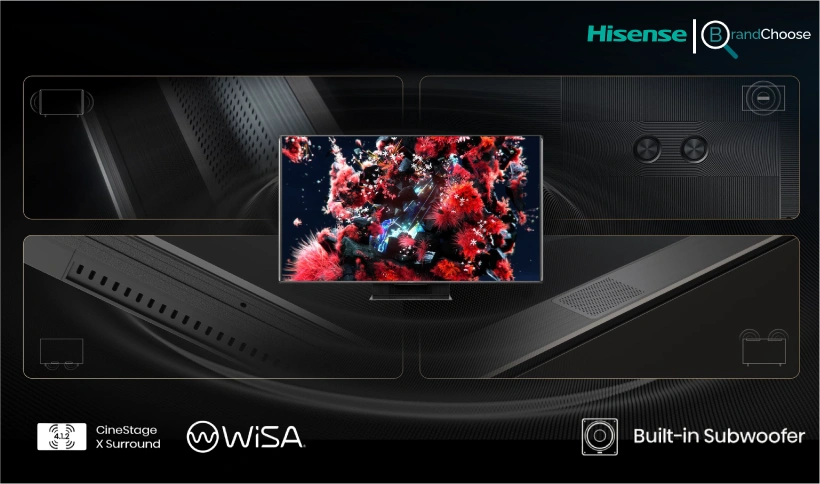
Sound Summary
Philips offers refined, immersive audio in its OLED models, ideal for cinematic viewing in quiet rooms. But across the board, Hisense consistently delivers louder, fuller sound with more advanced processing, especially in the mid and budget tiers where it’s harder to find strong built-in audio.
Smart TV & Connectivity
Smart TV platforms are the brain of your television — powering everything from app access to voice control, casting, personalization, and device integration. A good smart system should be fast, easy to navigate, and compatible with your ecosystem (Google, Alexa, Apple, etc.). Connectivity features like HDMI 2.1, Wi-Fi 6, or Bluetooth also affect how well the TV fits into your broader entertainment setup.
Both Philips and Hisense use third-party platforms like Google TV or Roku, but they implement them differently and offer varying smart feature depth across classes.
Premium Class
Philips OLED models run on Google TV, offering deep integration with Google Assistant, personalized content recommendations, and broad app support. The interface is clean, responsive, and supports Chromecast built-in, Google Photos, and multi-user profiles. Some models also include Ambilight+Hue syncing, letting users connect their Philips Hue lighting to match the content on screen — a standout for ambience-focused setups.
Hisense U9 and U8 Series also run on Google TV, with support for Dolby Vision IQ, IMAX Enhanced content, and hands-free voice control via far-field microphones. These models feature Wi-Fi 6, Bluetooth 5.2, and multiple HDMI 2.1 ports, making them excellent for modern AV setups, next-gen consoles, or smart home integration. Everything feels fast, modern, and feature-packed for power users and gamers.
Mid-Range Class
Philips 7600 and 7900 Series also use Google TV, though without Ambilight+Hue or multi-zone light syncing. App performance is smooth, and voice control via the remote works well, though there’s no hands-free capability. Connectivity includes standard HDMI 2.1, eARC, and Bluetooth, making them suitable for streamers, gamers, or casual smart home use.
Hisense U7 and U6 Series run the same Google TV interface, but with some extras like Game Bar, Multi-View (split-screen), and faster loading speeds. These models retain HDMI 2.1 ports and often offer ALLM (Auto Low Latency Mode) and VRR, making them a better fit for gamers or advanced media setups.
Budget Class
Philips 6000 and 6600 Series vary — some models use Google TV, others use Roku TV, depending on the region and retailer. Both are functional, but not particularly fast. Voice control is usually available only through the remote, and connectivity is limited to basic HDMI/eARC and Wi-Fi 5. Suitable for basic streaming setups or secondary rooms.
Hisense A6/A7 models give users more choice: Google TV, Fire TV, Roku TV, or Hisense's own VIDAA platform — depending on model. Many include Game Mode Plus, Alexa or Google Assistant integration, and faster boot-up times than most competitors at this price. Bluetooth is common, and app support is broad. These TVs work well for budget-conscious users who still want flexibility and voice control.
Smart TV & Connectivity Summary
Philips offers a smooth, reliable smart experience across its lineup, with Ambilight syncing adding a unique layer of interaction at the high end. But Hisense consistently delivers more features, broader platform choices, and better gaming integration, especially in the mid and budget tiers.
Brightness
Brightness determines how well your TV performs in bright rooms, during daytime viewing, or when displaying HDR content with dramatic highlights. A TV with low peak brightness might look great at night but struggle to maintain contrast and color in sunlit spaces. Brightness also impacts how immersive movies, games, and sports feel — especially when showing high-dynamic range effects like reflections, explosions, or sunlight.
Different panel technologies handle brightness differently. OLED (used by Philips) is known for deep contrast but often lower overall luminance, while Mini-LED (used by Hisense) pushes peak brightness much higher, making it more suitable for demanding lighting conditions.
Premium Class
Philips OLED models, such as the OLED807, reach 1,000 to 1,300 nits at peak — a strong result for OLED. This brightness is more than enough for dark rooms and cinematic environments, especially when paired with perfect black levels and Ambilight’s atmospheric glow. But in brighter spaces, they can’t match the searing impact of top-end LED models.
Hisense U9 and U8 Series use advanced Mini-LED backlighting, delivering up to 2,000–2,500 nits of peak brightness. HDR highlights are dazzling, and the display remains vivid even in sunlit rooms. With Dolby Vision IQ onboard, the TV can adjust brightness dynamically based on your environment — making it a top-tier choice for daylight and HDR-heavy content.
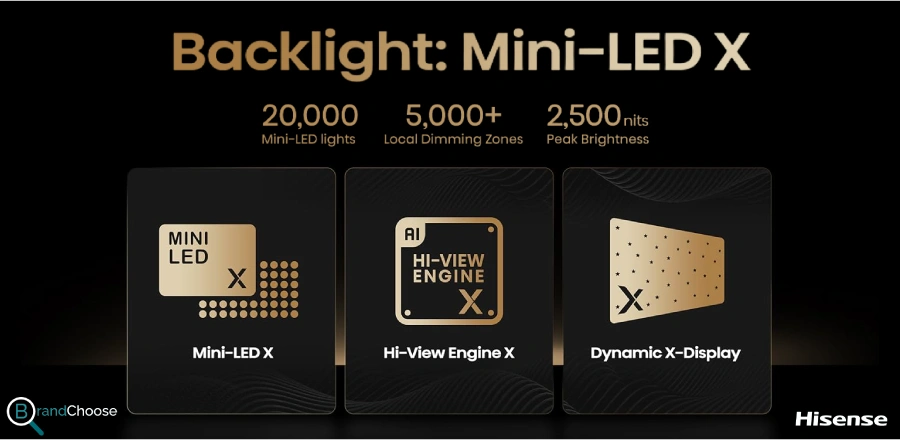
Mid-Range Class
Philips 7600 and 7900 Series offer respectable 500–700 nits, which is fine for most living rooms and casual HDR viewing. These QLED models deliver decent punch in SDR and HDR scenes, but without Mini-LED, they lack the dynamic range and brightness layering that HDR thrives on. Best suited for moderate lighting setups where you don’t need the screen to overpower daylight.
Hisense U7 and U6 Series blow past typical mid-range expectations, reaching 1,000 to 1,500 nits with Mini-LED backlighting. They provide excellent visibility in bright rooms, clear detail in HDR content, and a far more impactful visual experience overall. Whether you’re watching sports during the day or HDR movies at night, these models perform like higher-end sets.
Budget Class
Philips 6000 and 6600 Series are basic LED TVs that peak around 300–400 nits. That’s enough for casual streaming in dim environments but insufficient for realistic HDR. If you’re watching in a room with sunlight or bright lamps, the image can appear washed out or flat.
Hisense A6 and A7 Series offer a modest bump — typically 400–500 nits, along with better HDR tone mapping and often support for Dolby Vision. While still budget-tier, they hold up better for everyday mixed-use, especially when lighting conditions aren’t ideal.
Brightness Summary
Hisense dominates the brightness category across all tiers, especially in mid-range and premium classes where its Mini-LED tech delivers bold HDR and sunlit performance. Philips holds its own in controlled lighting, but it simply can’t match the sheer luminance output Hisense delivers.
Smart Features
Smart features go beyond apps — they shape how your TV interacts with you and your environment. From AI-enhanced image processing to gaming-specific modes, voice assistants, content personalization, and even light syncing, smart features can transform your TV into a dynamic home hub.
Both Philips and Hisense rely on platforms like Google TV, but their approach to smart functionality — especially around AI, gaming, and ecosystem integration — varies by model class.

Premium Class
Philips OLED models use Google TV, offering a responsive interface with personalized recommendations, voice assistant support, and multi-user profiles. More importantly, they include AI Picture Style, which adjusts sharpness and contrast based on the scene. What sets Philips apart is Ambilight + Hue integration, which connects your TV to smart lighting for a more immersive experience — ideal for mood-driven viewing and ambient setups.
Hisense U9 and U8 Series also use Google TV but enhance it with features like Dolby Vision IQ, Filmmaker Mode, and Game Mode Pro, which activates 165Hz refresh, VRR, and ALLM. Their AI Picture optimization auto-adjusts brightness and color, and features like hands-free voice control and Google Home/Alexa integration make them great for gamers or smart home users who want deep control and responsiveness.
Mid-Range Class
Philips 7600 and 7900 QLED models offer AI Picture Tuning Lite, 144Hz Game Mode, and standard Google TV functionality. While they lack the deeper smart lighting sync of premium models, the interface remains intuitive, voice search is accurate, and app support is extensive. These TVs work well for gamers and streamers who want a clean interface without complexity.
Hisense U7 and U6 Series push harder with Game Mode Pro, AI Brightness Control, and Auto Genre Detection. Google TV runs smoothly, and most models include Quick Access Game Bar, hands-free Google Assistant, and Smart Home compatibility — making them feel more “alive” in terms of user responsiveness and automation.
Budget Class
Philips 6000 and 6600 Series use either Roku TV or Google TV, depending on the model. Both offer reliable performance, but lack advanced AI processing or deeper integrations. These TVs are best for basic streaming and app browsing, with limited personalization or smart ecosystem tie-ins.
Hisense A6/A7 Series performs surprisingly well at this level. Many include Game Mode Plus, Dolby Vision, and basic AI enhancement tools like light/dark scene recognition. Some models use Fire TV or VIDAA OS (Hisense’s in-house system), offering voice assistant integration and decent app performance. Ideal for value-focused users who still want a modern smart experience.
Smart Features Summary
Philips offers a smart, immersive experience with AI picture tuning and Ambilight integrations that work beautifully for cinematic and ambient use. But Hisense pulls ahead in interactivity, gaming features, and smart home compatibility, especially for users who want faster control and broader functionality.
Remote Control
A good remote can make or break your smart TV experience. It’s your primary way to navigate apps, control playback, adjust settings, and access voice assistants. In modern TVs, remotes are expected to offer streamlined layouts, voice control, dedicated app buttons, and — in higher-end models — even extras like backlighting or hands-free voice. While often overlooked, a thoughtful remote can significantly improve day-to-day usability.
Philips and Hisense both offer solid remotes across their lineups, but differ in ergonomics, button layout, and smart feature access — especially as you move up or down the price ladder.
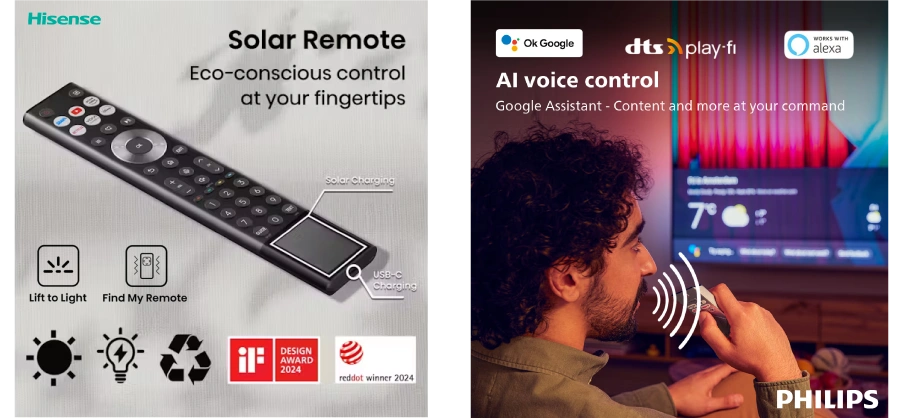
Premium Class
Philips OLED remotes are minimalist but functional. They typically include voice control via Google Assistant, dedicated app shortcuts, and a unique Ambilight toggle. Some premium remotes also support Bluetooth pairing, reducing input lag and allowing control without line-of-sight. The design is compact and clean, perfect for those who value simplicity with purpose — especially in dark rooms where Ambilight matters.
Hisense U9 and U8 Series remotes are designed for power users. They often include backlit keys, a built-in microphone for voice commands, and quick access buttons for services like Netflix, YouTube, and Disney+. The layout is slightly larger than Philips’ but more feature-rich. Some models even offer solar charging or USB-C. These remotes are great for multi-user households and gaming setups where quick access and visibility matter.
Mid-Range Class
Philips 7600 and 7900 models use the standard Google TV remote — lightweight, ergonomic, and equipped with voice control. The layout is clean, and build quality is decent. No frills here, but it works well for everyday use in media-driven environments.
Hisense U7 and U6 Series remotes feel more premium for the price. They retain voice functionality, better tactile feedback, and clearer button labeling. Many include a Game Bar shortcut or special buttons tied to platform features. For users who bounce between streaming, gaming, and smart control, Hisense’s remotes offer more flexibility at this level.
Budget Class
Philips 6000 and 6600 Series remotes vary by platform (Roku or Google TV), but are often basic in design — small, IR-based, and without voice input in some models. Usable, but clearly built for simple navigation and low-cost delivery.
Hisense A6, A7, and A4 models offer platform-based remotes too — but many include voice search, quick app access, and better grip design. Even the Fire TV and VIDAA remotes feel more modern and responsive than Philips at this level. These are a better fit for users who want functionality without extra devices.
Remote Control Summary
Philips offers clean and consistent remotes with Ambilight control and Google integration, but Hisense goes further with premium touches like backlighting, voice-first layout, and platform-specific shortcuts, especially useful for gamers and frequent streamers.
Final Verdict
Philips and Hisense cater to different priorities. Philips is all about cinematic precision, minimalist design, and the immersive magic of Ambilight. It shines in dark-room viewing, OLED contrast, and premium simplicity. Hisense, on the other hand, is focused on powerful performance for the price — delivering Mini-LED brightness, gaming-centric features, and wider affordability across nearly every tier.
📺 Which One’s Right for You?
✅ Choose Philips if you want:
Deep contrast and color accuracy (especially with OLED)
Elegant design with ambient lighting (Ambilight)
A simplified, cinematic experience in darker viewing setups
Google TV with a clean, uncluttered interface
✅ Choose Hisense if you want:
Mini-LED brightness and impactful HDR
Advanced gaming features like 165Hz, VRR, and Game Mode Pro
Strong performance across every price tier
Frequent discounts and more model availability
Conclusion
If you're shopping based on style, subtlety, and visual immersion, Philips holds the edge — especially for movie lovers and minimalist setups.
But if you want raw power, brightness, features, and affordability, Hisense is the clear leader.
















